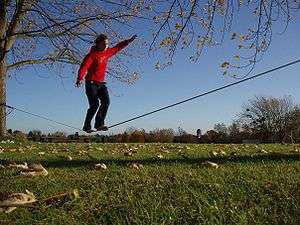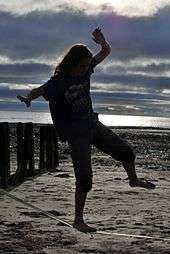Slacklining

Slacklining refers to the act of walking or balancing along a suspended length of flat webbing that is tensioned between two anchors. Slacklining is similar to slack rope walking and tightrope walking. Slacklines differ from tightwires and tightropes in the type of material used and the amount of tension applied during use. Slacklines are tensioned significantly less than tightropes or tightwires in order to create a dynamic line which will stretch and bounce like a long and narrow trampoline. Tension can be adjusted to suit the user, and different webbing may be used in various circumstances. Slacklining is popular because of its simplicity and versatility; it can be used in various environments with few components.
Styles of slacklining

Urbanlining
Urbanlining or urban slacklining combines all the different styles of slacklining. It is practiced in urban areas, for example in city parks and on the streets. Most urban slackliners prefer wide 2-inch (5 cm) lines for tricklining on the streets, but some may use narrow (5⁄8 or 1 inch, 1.6 or 2.5 cm) lines for longline purposes or for waterlining. Also see the other sections of slackline styles below.
One type of urbanlining is timelining, where one tries to stay on a slackline for as long as possible without falling down. This takes tremendous concentration and focus of will, and is a great endurance training for postural muscles.

Another type of urbanlining is streetlining, which combines street workout power moves with the slackline's dynamic, shaky, bouncy feeling. Main focus are static handstands, super splits — hands and feet together, planche, front lever, back lever, one arm handstand and other interesting extreme moves that are evolving in street workout culture.
Tricklining
Tricklining has become the most common form of slacklining because of the easy setup of 2-inch (5 cm) slackline kits. Tricklining is often done low to the ground but can be done on highlines as well. A great number of tricks can be done on the line, and because the sport is fairly new, there is plenty of room for new tricks. Some of the basic tricks done today are walking,[1] walking backwards, turns, drop knee, running and jumping onto the slackline to start walking, and bounce walking. Some intermediate tricks include: Buddha sit, sitting down, lying down, cross-legged knee drop, surfing forward, surfing sideways, and jump turns, or "180s." Some of the advanced tricks are: jumps,[2] tree plants, jumping from line-to-line, 360s, butt bounces, and chest bounces. With advancements in webbing technology & tensioning systems, the limits for what can be done on a slackline are being pushed constantly. It is not uncommon to see expert slackliners incorporating flips and twists into slackline trick combinations.
Waterlining
Waterlining is slacklining over water. This is an ideal way to learn new tricks, or to just have more fun. Common places to set up waterlines are over pools, lakes, rivers, creeks, between pier or railroad track pillars, and boat docks. The slackline can be set up high over the surface of the water, close to the surface or even underneath the surface. It is important, however, that the water be deep enough, free from obstacles, and that the area should not be travelled by boats.
Highlining
Highlining is slacklining at elevation above the ground or water. Many slackliners consider highlining to be the pinnacle of the sport. Highlines are commonly set up in locations that have been used or are still used for Tyrolean traverse. When rigging highlines, experienced slackers take measures to ensure that solid, redundant and equalized anchors are used to secure the line into position. Modern highline rigging typically entails a mainline of webbing, backup webbing, and either climbing rope or amsteel rope for redundancy. However, many highlines are rigged with a mainline and backup only, especially if the highline is low tension (less than 900 lbf (410 kgf; 4,000 N)), or rigged with high quality webbing like Type 18 or MKII Spider Silk. It is also common to pad all areas of the rigging which might come in contact with abrasive surfaces. To ensure safety, most highliners wear a climbing harness or swami belt with a leash attached to the slackline itself. Leash-less, or "free-solo" slacklining – a term borrowed from rockclimbing – is not unheard of, however, with proponents such as Dean Potter and Andy Lewis.[3]
Slackline yoga
Slackline yoga takes traditional yoga poses and moves them to the slackline. It has been described as "distilling the art of yogic concentration". To balance on a 1-inch (2.5 cm) piece of webbing lightly tensioned between two trees is not easy, and doing yoga poses on it is even more challenging. The practice simultaneously develops focus, dynamic balance, power, breath, core integration, flexibility, and confidence. Using standing postures, sitting postures, arm balances, kneeling postures, inversions and unique vinyasa, a skilled slackline yogi is able to create a flowing yoga practice without ever falling from the line.

Slackline yoga has been covered in The Wall Street Journal,[4] Yoga Journal[5] and Climbing Magazine.[6]
Freestyle slacklining
Freestyle slacklining (a.k.a. “rodeo slacklining") is the art and practice of cultivating balance on a piece of rope or webbing draped slack between two anchor points, typically about 15 to 30 feet (455 to 915 cm) apart and 2 to 3 feet (60 to 90 cm) off the ground in the center. This type of very "slack" slackline provides a wide array of opportunities for both swinging and static maneuvers. A freestyle slackline has no tension in it, while both traditional slacklines and tightropes are tensioned. This slackness in the rope or webbing allows it to swing at large amplitudes and adds a different dynamic. This form of slacklining first came into popularity in 1999, through a group of students from Colby College in Waterville, Maine. It was first written about on a website called the "Vultures Peak Center for Freestyle and Rodeo Slackline Research" in 2004. The article "Old Revolution — New Recognition - 3-10-04" describes these early developments in detail.
Windlining
Windlining is a practice of slacklining performed in very windy conditions. Depending on the intensity of the wind, it can be difficult to remain on the line without being blown off. The sensation one experiences is like flying as the slacker must angle his body and arms in an aerodynamic manner to maintain balance.
History
While rope walking has been around in one manner or another for thousands of years, the origins of modern-day slacklining is generally attributed to a young rock climber named Adam Grosowsky from southern Illinois in 1979.[7] A then sixteen-year-old Adam, the son of the head of Southern Illinois University's Design Department, became obsessed with a photo he found in the university library with the understated caption "Circus Performers c1890"; the photo depicted a wire bolted low on a wall on one end and the other terminating in a wristloop held by a performer doing a one-hand handstand on the top of a flagpole with his body canted far to the opposite side counterbalancing the weight of the wire. In the middle of that wire was another performer in a handstand. Adam successfully harassed the small band of local climbers into almost believing they could reproduce this feat. They all set about learning to walk on climbing ropes, webbing, chains and low / high wires, but only Adam managed to carry through with achieving some elements of that historic circus feat, most notably being able to maintain an indefinite handstand on 1-inch (2.5 cm) webbing and even getting it rocking side-to-side while in the handstand. Adam carried those bad habits to Olympia, Washington's The Evergreen State College in 1979,[8] where he met fellow climbers Jeff Ellington and Brooke Sandahl. Adam set up his permanent heavy highwire in the woods on campus while the trio continued to perfect walking, handstands, and jump mounts on webbing. Their handstand work focused on 1-inch (2.5 cm) flat climbing webbing and they also employed the dynamics and flexibility of the nylon webbing to develop all manner of other tricks, including a three-club passing (juggling) routine between two slackliners balanced simultaneously on the same line. Red Square, Evergreen's central campus plaza, was a convenient between-class practice area where they often drew crowds of spectators. Grosowsky, along with Ellington were fascinated with wirewalking history and circus culture from the start, and in 1981 performed leashless on a 30-foot (9 m) highline strung 25 feet (8 m) over a concrete floor as part of a project to recreate a traditional one-ring circus in The Evergreen State College's main performance auditorium. During this period Grosowsky, who is now a regionally well-known Northwest artist, devoted much of his lithographic art to themes involving wirewalking and circus culture. The sport blossomed within the West Coast rock climbing community, and then spread to other areas. It got attention during the 2016 Rio Olympics when slackliner Giovanna Petrucci performed on the beach at Ipanema, attracting the attention of the New York Times.[9]
A professional slackliner was credited with climbing a ski lift tower in Colorado and shimmying across a cable to save a man caught by a ski lift in January 2017.[10]
Highlining history
Highlining was inspired by a number of highwire artists who walked steel cable up high in unique places. From 1907-1948, Mr. Ivy Baldwind of Eldorado Springs, Colorado crossed Eldorado Canyon on a high wire numerous times. His final crossing was documented on his 82nd birthday.[11] On August 7, 1974 Philippe Petit set-up and crossed a high wire between the Twin Towers of the World Trade Center in New York.[12] In the summer of 1983, Adam Grosowsky and Jeff Ellington set up a 55-foot (17 m) high wire at Yosemite's Lost Arrow Spire that was nearly 2,890 feet (880 m) high. However, neither of them were able to completely cross this line because of inadequate guying. In the autumn of 1983, inspired by Jeff and Adam's efforts, a 20-year-old Scott Balcom and 17-year-old Chris Carpenter successfully completed what is believed to be the first documented high walk on nylon webbing,[8][13] instead of using cable, giving birth to what slackliners now call highlining. This first highline, referred to as The Arches,[14] was a span about 30 feet (9 m) long and about 120 feet (35 m) above ground in Pasadena, California under the California SR 134 Freeway bridge, between two arches that spanned the trickling Arroyo Seco below. The next summer (1984), Scott Balcom set up a highline on Yosemite’s Lost Arrow Spire with the help of Darrin Carter and Chris Carpenter. Scott’s attempt, however, was unsuccessful (neither Darrin nor Chris made an attempt). On July 13, 1985, Scott Balcom returned and successfully crossed the now-famous Lost Arrow Spire highline.[15] In June 1990, Chris Carpenter purposefully "surfed" a highline spanning the gap of Horsetooth Rock in Fort Collins, Colorado. In 1993, Darrin Carter became the second person to successfully cross the Lost Arrow Spire highline.[12][16] In 1995, Darrin Carter performed unprotected crossings of the Lost Arrow Spire in Yosemite and The Fins, in Tucson, AZ on Mt. Lemmon highway.[8] On July 16, 2007, Libby Sauter became the first woman to successfully cross the Lost Arrow Spire,[17] with Jenna McLennan walking it shortly after.[18] In 2008, Dean Potter became the first person to BASE jump from a highline at Hell Roaring Canyon in Utah.[19] On September 10, 2011, Chris Rigby and Balance Community: Slackline Outfitters owner Jerry Miszewski established the Balance Community Highline Festival in Garden Valley, California. There has been a highline fest each month since; nine highlines are set up, ranging 35 to 400 feet (10 to 120 m) long for highliners from across the U.S. to come train on.[20][21][22]
World records
Longest highline
The last highline record was set by the team Slack.fr in le Cirque de Navacelles in France, the line was 1662 meters long and 334 meters high. [23] In Aiglun, France, on Tuesday, April 19, 2016 Nathan Paulin, along with Danny Menšík, set a new record for the longest slackline ever – 1020m.[24] The highline was 600 meters high at its highest point.
The longest highline walked by a woman, with a length of 222m at 400m high was set in Hunlen Falls, in Northern British Columbia on 24 August 2016 by Mia Noblet.[25]
Longest free solo highline
The longest free solo highline was walked in Hunlen Falls, in Northern British Columbia August, 2016. At a length of 72m and 400m high, it was walked by Friedi Kühne.[26] The longest free solo highline by a female is held by Faith Dickey, who walked a 28-meter-long highline in Ostrov, Czech Republic in August 2012. The line was 25 meters high.
Highest slackline
The highest slackline on record was walked by Christian Schou on August 3, 2006 at Kjerag in Rogaland, Norway. The slackline was 1,000 metres (3,281 ft) high. The project was repeated by Aleksander Mork in September 2007.
The current record for walking the highest and longest urban highline is held by professional slackliner Alexander Schulz of Germany, who walked a slackline at a height of 807 feet (246 m) on December 4, 2016 between the Torre BBVA Bancomer and Torre Reforma in Mexico City, Mexico. Alexander Schulz walked successfully the 712 feet (217 m) long slackline that was stretched over the wide avenue Paseo de la Reforma.[27][28][29][30]
Longest slackline (longline)
The longest slackline, with a length of 610 metres (2,000 ft), was walked on May 9, 2015 by Alexander Schulz in Mongolia.[31]
The longest slackline walked by a woman, with a length of 230 metres (750 ft), was walked in September 2014 in Lausanne (CH) by Laetitia Gonnon.
See also
References
- ↑ "How To Walk a Slackline". Wikihow.
- ↑ "How to Slackline: Jump Line-to-Line". Wikihow.
- ↑ "US slackline walker Dean Potter crosses China canyon". BBC News. 23 April 2012.
- ↑ Alter, Alexandra (5 April 2008). "Into the Wild With Yoga". The Wall Street Journal. Retrieved 8 November 2012.
Jason Magness meditates in full-lotus posture balanced on a slackline over the Arizona desert.. He's also the innovator of slackline yoga and is one of its few masters.
- ↑ Bolster, Mary. "A climbing yogi has found a unique way to improve his balance, focus, and core strength: Doing yoga poses on a slackline". Yoga Journal. Retrieved 8 November 2012.
- ↑ Nadlonek, Ryan. "Highballin' – The Spot Gym Goes Off for Highball Comp". Climbing.com. Retrieved 8 November 2012.
they ran a slackline 20-feet in the air and tied in some of the area's most balanced men and women for toproped highline highjinx... The high-line event, which took place January 24, 2009, was a best-trick competition, with each slacker receiving three minutes to show their skills. Highlights included Greg Kalfa's ballsy backflip attempt and Josh Beau, looking as at home on the webbing as anyone else did on the ground (especially during his side-plank and other yoga-inspired moves).
- ↑ "Above the Lawn, Walking the Line". New York Times; Sept. 8, 2006 https://www.nytimes.com/2006/09/08/travel/escapes/08slack.html
- 1 2 3 Alpinist, Issue 21, Autumn 2007, "The Space Between, a history of funambulism" by Dean Potter
- ↑ ANNA JEAN KAISER (August 18, 2016). "This Rio Phenom Would Be a Lock for a Gold. If There Were One for Slacklining". New York Times. Retrieved August 18, 2016.
..Petrucci is a world-champion slackliner, ... front flips and back flips and falls flat on the five-centimeter-wide strap, her torso parallel to the ground. ...If slackline were an Olympic sport, Petrucci, 18, would be a lock for gold....
- ↑ http://www.seattletimes.com/life/outdoors/man-dangling-by-neck-from-ski-lift-saved-by-professional-slackliner/
- ↑ Rudolph M. Olson and the Carnegie Branch of the Boulder Public Library. https://www.youtube.com/watch?v=oJLBvBIoJ88
- 1 2 "The History of Slacklining". Archived from the original on 2011-07-19.
- ↑ Walk the Line — the art of balance and the craft of slackline, by Scott Balcom 2005 ISBN 0-9764850-0-1
- ↑ "The Arches – 1983". rockclimbing.com.
- ↑ "First Slackline Crossing of the Lost Arrow Spire". YouTube. 24 May 2009.
- ↑ "History of Slacklining". slackline.com.
- ↑ YouTube: First Woman Walks the Lost Arrow Spire Highline
- ↑ "First Woman to Walk the Lost Arrow Spire". slackline.com. 2008.
- ↑ Longman, Jeré (14 March 2008). "900 Feet Up With Nowhere To Go But Down". The New York Times.
- ↑ "Slacklining". CBS Local. (video)
- ↑ Rigby, Chris; Miszewski, Jerry (9 September 2011). "Balance Community's Backyard Highline Fest". Facebook.
- ↑ "Balance Community Backyard Highline Festival: Volume VI". Facebook. 13 April 2012.
- ↑ {{cite¦url:https://fr.wikipedia.org/wiki/Slackline#Highline_2}}
- ↑ redbull.com http://www.redbull.com/en/adventure/stories/1331789988303/these-guys-just-crossed-a-1020m-slackline. Missing or empty
|title=(help) - ↑ "MEET MIA - THE NEW FEMALE WORLD RECORD HOLDER [VIDEO]!". Retrieved 2016-09-27.
- ↑ Leftcoast (2016-09-01), New Free Solo Highline World Record by Friedi Kühne | shot in 4k, retrieved 2016-09-27
- ↑ https://uk.news.yahoo.com/barefoot-walker-breaks-world-record-in-nail-biting-high-line-stroll-105707746.html
- ↑ http://www.spiegel.de/video/slackline-alexander-schulz-mit-weltrekord-in-mexiko-stadt-video-1726357.html
- ↑ http://nortedigital.mx/alexander-schulz-atraviesa-reforma-mas-200-metros/
- ↑ https://www.ratchetstraps.com/slackline
- ↑ Fullerton, Jamie (2015-05-14). "Daredevil breaks world slackline record with 610m walk in Mongolian desert". Daily Mail.
External links
| Wikimedia Commons has media related to Slacklining. |
